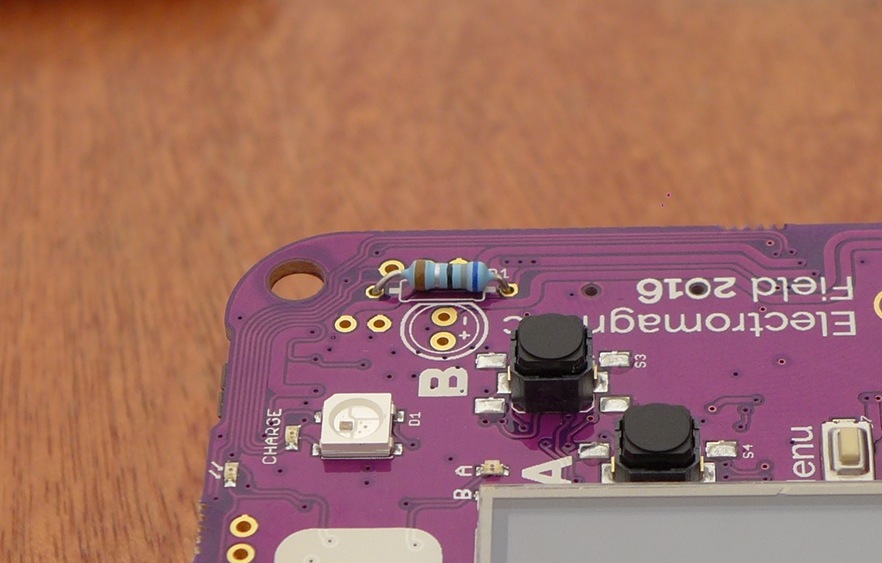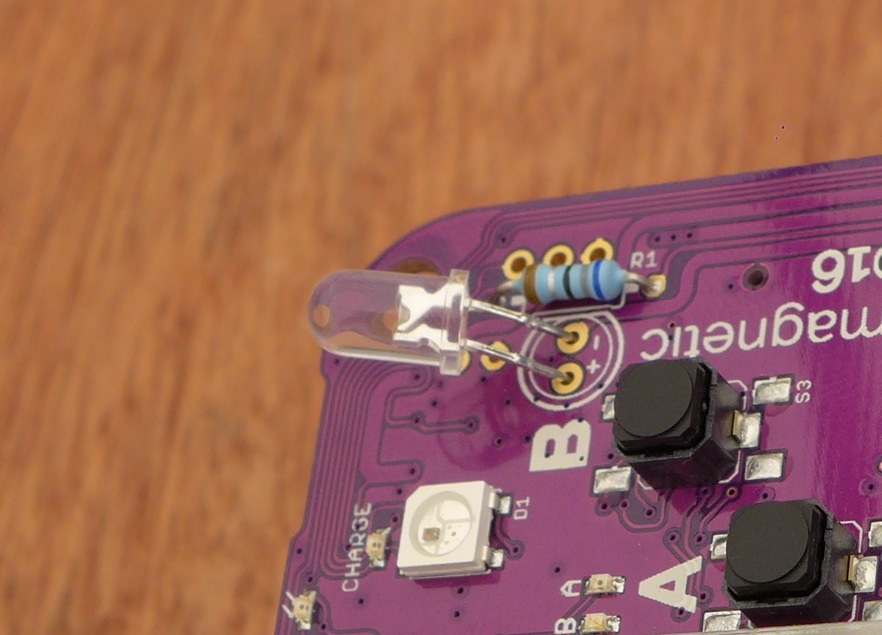TiLDA MK3/Introduction to badge hacking: Difference between revisions
No edit summary |
No edit summary |
||
| Line 76: | Line 76: | ||
# Appname : Torch | # Appname : Torch | ||
# Built-in: no | # Built-in: no | ||
import pyb | import pyb | ||
import ugfx | import ugfx | ||
import dialogs | import dialogs | ||
pin = pyb.Pin("LED_TORCH") | pin = pyb.Pin("LED_TORCH") | ||
pin.high() | pin.high() | ||
Revision as of 11:22, 6 August 2016
Beginners Guide to Badge Hacking
We're going to create an LED torch for seeing our way around the camp.
Soldering the LED
You should have received an LED and a resistor with your badge. First, grab the resistor. Bend the legs over so they fit in the holes in the board, using the resistor lead bender.
It doesn't matter way round the resistor goes.
Flip over your board and solder the resistor in place, then trim down the legs to be flush against the board.
Next, the LED. It does matter which way round the LED goes - look for a flat side on the LED and match it up with the flat side on the board. Pull your LED out about a centimetre and bend it over a bit.
Flip the board over and solder the LED into place.
Testing
Plug your badge into your laptop, and use the information on [1]https://micropython.org/doc/tut-repl to connect to the usb-serial port. If you hit Ctrl-C, you drop out of the badge software, and get a REPL prompt. You can tell this is working because you'll see three > symbols.
Type the following at the prompt. This should turn your LED on!
import pyb
pin = pyb.Pin("LED_TORCH")
pin.high()
Of course, thats a bit of a pain to do every time we want the LED on, so let's make an app!
The App
Your badge should have shown up as a USB drive. Open the folder apps, and create a folder within it called torch.
Create a file within this called main.py. This is your app's main file. Open it in a text editor.
First, we need to tell the badge some details about your app. This is done in a header section at the top of the file
# Author: Your Name # Description: Torch # Category: Flashy # License: MIT # Appname : Torch # Built-in: no
You could save and run your app now, but it wont actually do anything yet. Lets add the code:
# Author: Your Name # Description: Torch # Category: Flashy # License: MIT # Appname : Torch # Built-in: no
import pyb
pin = pyb.Pin("LED_TORCH")
pin.high()
while True:
pass
Save, and run your app. When you run it the LED should turn on, brill!
Of course, we're not showing anything on the screen. Lets have a nice notice box to show we're in the torch instead of that while loop.
# Author: Your Name
# Description: Torch
# Category: Flashy
# License: MIT
# Appname : Torch
# Built-in: no
import pyb
import ugfx
import dialogs
pin = pyb.Pin("LED_TORCH")
pin.high()
ugfx.init()
ugfx.clear(ugfx.html_color(0x7c1143))
dialogs.notice("Shine a light!", title="Torch", close_text="Exit")
Run your app again and you should have a nice button you can press to shine a light in the camp!
You can unplug the badge from your computer when the LED has finished flashing, but we recommend you eject the drive first.


